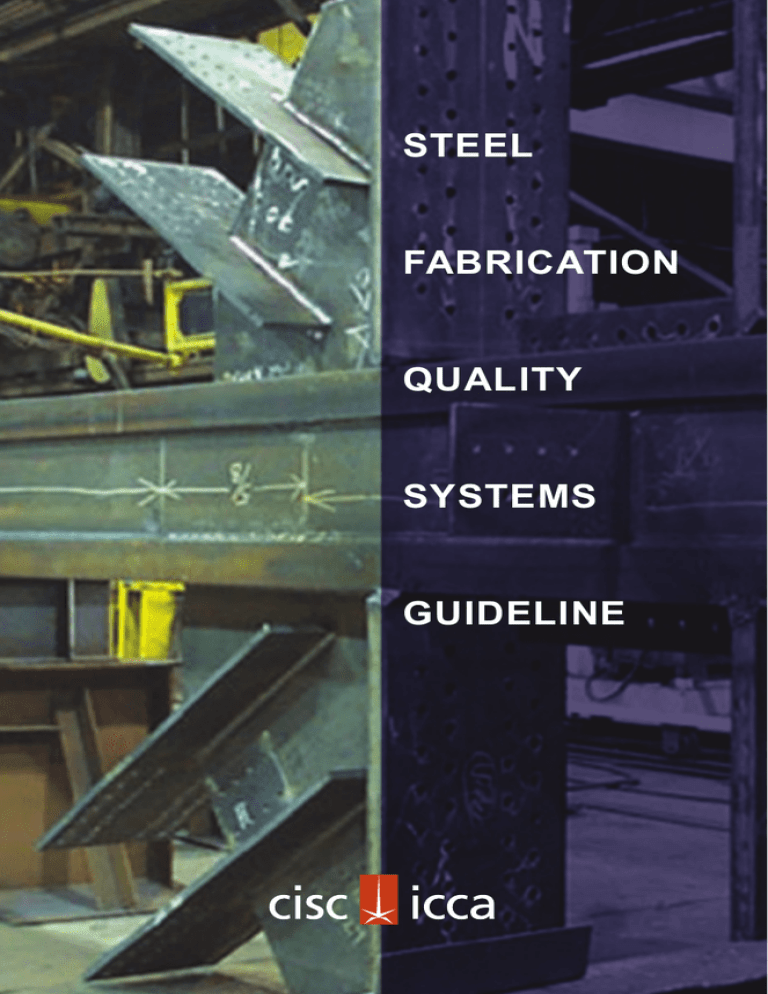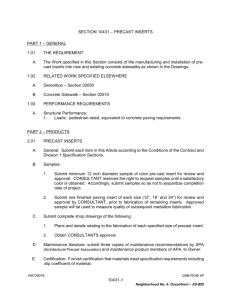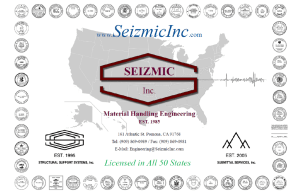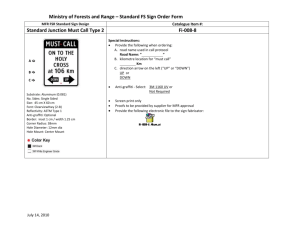
STEEL
fabrication
quality
systems
guideline
Copyright 2002
by
Canadian Institute of Steel Construction
All rights reserved. This book or any part therof must not be
reproduced in any form without written permission of the
publisher.
First Printing October 2002
PRINTED IN CANADA
by
MacNab Print
A Division of Cameron Publications Limited
Dartmouth, NS
CISC
Steel Fabrication
Quality Systems Guideline
Published by the
CANADIAN INSTITUTE OF STEEL CONSTRUCTION
300 – 201 Consumers Rd
Willowdale (Toronto), Ontario
M2J 4G8
TABLE OF CONTENTS
Preface
1. Scope and Aims of Manual
2.
Normative Reference
3. Terms and Definitions
4. 1.1
1.2
1.3
1.4
Quality System Requirements
General Requirements
Work Procedures
Control of Documents
Control of Quality Records 5. 1.1
1.2
1.3
Management Responsibility
Management Commitment
Organization
Responsibility and Authority
6. 1.1
Resource Management
Welding Personnel
7.
1.1
1.2
1.3
1.4
1.5
1.6
1.7
1.8
7.9
7.10
Process Management
QC Planning
Contract Review Purchasing
Receiving
Material Verification
Control of Workmanship
Product Verification
Customer Supplied Products
Storage, Loading, and Shipping
Control of Measuring and Inspection Equipment
8.
1.1
1.2
1.3
8.4
Measurement, Analysis, and Improvement
Control of Nonconformity Corrective Action Preventive Action Analysis of Data
PREFACE
The Canadian Institute of Steel Construction (CISC) is the
national industry association representing the structural steel,
open web steel joist, and steel plate fabricating industries in
Canada. The CISC functions as a not-for-profit organization
promoting the efficient and economic use of fabricated steel in
construction.
The CISC has prepared this Guideline in recognition of the
interest in meeting the quality requirements of its customers. It is designed to assist CISC Fabricators in developing a
Quality System that will provide assurance that products
will conform to contractual and regulatory requirements.
This guideline addresses the special processes and specific
requirements of the steel fabrication industry.
The Guideline is based on the belief that quality awareness
is an integral part of all production processes. By promoting
a "pride in workmanship" attitude in the employees, product
quality will be maintained in the most economical manner. The guideline has been prepared with reference to the following
publications:
(a) CSA S16
(b) CSA W59
(c) CSA W47.1
(d)
CISC Code of Standard Practice
(e)
ISO 9001:2000
(f)
ISO 9001:1994
Fabricators may choose to have their quality assurance
program audited and registered by a CISC approved, accredited
quality systems registration organization.
1. SCOPE AND AIMS OF MANUAL
The Quality Systems Manual, to be developed by the
Fabricator, shall define the scope of application with respect to
departments or systems included, and production location if
more than one location is covered.
2. NORMATIVE REFERENCE
Reference to the following documents, when made in this
guideline, refer to the most current published edition.
(a) CSA S16
(b) CSA W59
(c) CSA W47.1
(d) CISC Code of Standard Practice
3. TERMS AND DEFINITIONS
The following terms and definitions apply to this guideline or
are commonly used in the industry. The fabricator may choose
to include industry specific, or company specific terms and
definitions in this section.
Corrective Action
An action taken to eliminate the cause of a detected
nonconformity or other undesirable situation.
Defect
The non-fulfillment of a requirement that is recognized and corrected
while in current process. For example, a misplaced cleat detected
at the fit checking stage may be directed back to the fitting station
for proper relocation may be considered a defect and not a nonconformity.
Document
Information and its supporting medium used to define and/or
establish quality requirements.
Nonconformity
The non-fulfillment of a requirement.
Objective Evidence
Data supporting the existence or verity of something
Preventive Action
Action to eliminate the cause of a potential nonconformity or
other undesirable potential situation.
Quality Assurance
Quality assurance means to establish measures to prevent
problems and to demonstrate that such measures are taken
and are effective, providing confidence that the quality
requirements will be fulfilled.
Quality Control
Quality control encompasses activities aimed at determining
whether results obtained through an activity conform to stated
objectives for this activity. The results are measured and then
compared with a pre-established objective for this activity.
Quality Management System
A system to establish the policy and objectives required to
direct and control an organization with respect to quality and
to achieve those objectives.
Quality Objective
An aim or goal related to improvement in the quality system.
Quality Policy
Overall intentions and direction of an organization related to
quality as formally expressed by senior level management.
Record
A record is something stating results achieved or providing
evidence of activities performed.
Root Cause
The initial and main reason why an event occurs. In corrective
action, the removable factor leading to the elimination of future
nonconformity
4. QUALITY SYSTEM REQUIREMENTS
4.1 General Requirements
The Fabricator shall develop a Quality System Manual that
documents the processes necessary to provide assurance
that finished products conform to customer requirements in
accordance with the requirements of this guideline.
4.2 Work Procedures
The Quality System Manual shall be supported with applicable
work procedures and sample documents.
4.3 Control of Documents
4.3.1 General
The Fabricator shall establish and maintain procedures for
approval, issue, and maintenance of the documents and data
required for the operation of the Quality System. Required
documentation shall include, but may not be limited to, the
following:
(a)
Contract drawings, specifications, and amendments.
(b)
Detail and erection drawings.
(c)
Welding documentation as required by CSA W47.1.
(d)
Purchase orders.
4.3.2 Erection diagrams and shop details
4.3.2.1
The Fabricator or his assigned representative shall prepare shop
details and erection diagrams from Certified for Construction contract
documents. Preparation, use, and approval of these documents shall
conform to Section 5 of the CISC Code of Standard Practice, and
Provincial and Territorial Engineering Association guidelines, where
applicable.
4.3.2.2
Revisions to detail drawings/data shall be dealt with in the
same manner as the originals, or as agreed upon with the
Customer.
4.3.2.3
Current issues of appropriate documentation shall be available
at all points of use. Provision must be made to ensure that
obsolete drawings/data are removed from all points of use.
4.3.2.4
A shop drawing control system shall be maintained.
4.3.3
The Fabricator shall control the documentation required for
procured and subcontracted items.
4.3.4
The Fabricator shall ensure that all required documentation is
reviewed for adequacy prior to release.
4.3.5
The Fabricator shall define the retention period for
documentation, including consideration for requirements of
specific contracts and governing legislation.
10
4.4 Control of Quality Records
4.4.1
The Fabricator shall establish and maintain a system for the
identification, collection, and storage of the records determined
to demonstrate conformance to the requirements and effective
operation of the Quality System. Required records shall
include, but may not be limited to, the following:
(a)
(b)
(c)
(d)
(e)
(f)
(g)
Contract drawings, specifications, and amendments,
Mill test reports,
Purchase orders,
Applicable inspection and test records,
Calibration records for measuring and inspection
equipment,
Shipping and receiving reports,
Non-conformity, corrective action, and preventive action
reports.
4.4.2
All records required by the contract specifications shall be
available for review by the customer or his representative. 4.4.3
The Fabricator shall control the records required for procured
and subcontracted items.
4.4.4
The fabricator shall define retention periods for records,
including consideration for requirements of specific contracts
and governing legislation. 11
5. MANAGEMENT RESPONSIBILITY
5.1 Management Commitment
Management is responsible for ensuring that:
(a)
A documented statement is in place that describes
the Fabricator's Quality Policy with respect to commitment and quality objectives,
(b)
All employees are made fully aware of their authority
and role in the Quality System as described in section
5.3.1,
(c)
A Quality System that conforms to the requirements of
this guideline is implemented,
(d)
A senior level management representative is appointed
to ensure that the requirements of the Quality System
are maintained and reported,
(e)
A quality system audit is carried out at a maximum
interval of one year,
(f)
The Quality System is reviewed at a senior management
level at a maximum interval of one year, or more
frequently, to ensure it’s continuing suitability and
effectiveness,
(g)
Adequate resources are provided to carry out the
Quality System including performance and verification
of work.
12
5.2 Organization
5.2.1
The Fabricator shall define an organizational structure, which
includes the following functions as applicable:
QUALITY ASSURANCE
ENGINEERING
PRODUCTION
MANAGEMENT
DRAFTING
PURCHASING
SALES / ESTIMATING
PROJECT MANAGEMENT
5.2.2
This chart represents a typical organizational structure.
Departments may vary from company to company, and more
than one function may be held by one person. Any of the
functions noted may be subcontracted.
5.3 Responsibility and Authority
5.3.1
Each employee is responsible for the quality of his or her
own work and carries an equally important share in the
effectiveness of the quality assurance process. 5.3.1.1
All employees are responsible to ensure that the work
performed by them conforms to a standard of workmanship
required by the company in accordance with the applicable
contract requirements.
13
5.3.2
Management is responsible for ensuring that responsibility and
authority is defined for carrying out the following:
(a)
ensuring that all product quality verifications are
carried out on a continuous basis,
(b)
dealing with non-conformities and ensuring that the
specified dispositions are carried out on a continuing
basis,
(c)
communicating with the customer’s appointed
inspection representative(s),
(d)
work is carried out in accordance with the applicable
codes and standards;
(e)
all welding is in accordance with the latest requirements
of CSA Standards W47.1 and W59,
(f)
non-conformities of a technical nature are dealt with in
accordance with the applicable codes and standards,
(g)
ensuring that all production personnel understand the
contract requirements pertinent to their assignment,
(h)
providing sufficient notice and making proper
arrangements for required inspection,
(i)
ensuring that all contract requirements, including
revisions, are conveyed to the relevant departments
and incorporated into the detail drawings and other
fabrication data,
(j)
purchasing all items in accordance with the contract
requirements, including revisions, and for obtaining the
required documentation.
14
6. RESOURCE MANAGEMENT
Except as stated in Section 6.1, the Fabricator shall identify the
personnel and the corresponding level of education, training,
skills, and experience required in order to ensure that work
affecting product quality is carried out in the required manner.
6.1 Welding Personnel
Welders, welding operators, tack welders, welding supervisors,
and welding engineers shall be qualified to the requirements of
the latest issue of CSA standard W47.1.
7. PROCESS MANAGEMENT
7.1 QC Planning
The Fabricator shall determine the procedures, documentation,
records and resources required to ensure that their product
meets the customer requirements.
7.2 Contract Review
7.2.1
The Fabricator shall have a system in place to ensure that
contract requirements are reviewed and incorporated into the
work.
7.2.2
The Fabricator shall ensure that the necessary expertise,
personnel, equipment, and plant resources are available to
meet the contract requirements. 7.2.3
The Fabricator shall ensure that all additions and revisions to
contract requirements are duly communicated to the necessary
personnel, and incorporated into the work.
15
7.3 Purchasing
7.3.1
Purchase orders shall clearly describe the goods and services
being ordered. The descriptions shall include the following
information as applicable to the product being purchased:
(a)
(b)
(c)
(d)
(e)
(f)
(g)
(h)
(i)
(j)
(k)
(l)
(m)
(n)
Quantity
Unit of Measure
Product Name
Manufacturers Description
Size and Length
Material Specification
Special Properties (e.g. Impact Category)
Finish
Inspection Instructions
Special Packaging or Shipping Instructions
Applicable standards
Scope of work
Attachments to the purchase order
Tolerances
7.3.2
For subcontracted work, the Fabricator is responsible to ensure
that the final product meets the customer requirements.
7.3.3
Specifications, drawings, process requirements, inspection
instructions and other relevant technical data shall accompany
the purchase order if applicable.
7.3.4
Purchase orders shall clearly specify the written documentation
that shall be provided to verify conformance with purchase
orders.
16
7.4 Receiving
7.4.1
Incoming materials shall be matched against receiving slips
and purchase orders.
7.4.2
Nonconformities that are identified at the receiving stage
shall be dealt with in accordance with Section 8.1, Control of
Nonconformity.
7.4.3
Material shall not be used or processed until it has been
inspected and approved for use.
7.5 Material Verification
7.5.1
The Fabricator shall be able to verify the material specification
of all items in stock, and incorporated into the work.
7.5.2
Where individual pieces, lots, and batches are restocked, the
identification system shall be maintained.
7.6 Control of Workmanship
7.6.1
All employees shall be made aware of their responsibilities
under Section 5.3.1 of this Guideline as they apply to
workmanship.
7.6.2
Workmanship and tolerances shall conform to the applicable
clauses in the latest editions of CSA Standards S16, W59, and
to the CISC Code of Standard Practice.
17
7.6.3
Fabricators performing welding shall be certified by the
Canadian Welding Bureau in accordance with the requirements
of CSA Standard W47.1.
7.6.4
The Fabricator shall ensure that manufacturing operations
are carried out under controlled shop conditions. Controlled
shop conditions shall include all conditions that affect product
quality and the achievement of customer requirements.
7.6.5
All tools and equipment used shall be suitable to perform the
work and shall be in proper working order.
7.7 Product Verification
The Fabricator shall verify conformance to the contract
requirements.
7.7.1
The Fabricator shall define inspection points and inspection
record requirements to verify conformance to the contract
requirements, including the following:
(a)
Examination of material for size, conformance to
dimensional tolerances, and surface condition or defects, (b)
(c)
Examination of assemblies for overall dimensions, and
location and orientation of holes and detail components, Verification that welding is carried out in accordance
with the company's welding standards. This includes
visual examination of completed weldments,
(d)
Examination of surface preparation and finish.
18
7.7.2
Any additional inspection requirements noted in the contract
documents shall be identified and implemented.
7.7.3
The Fabricator shall provide access to and cooperation with
the Customers' designated representative for inspection of the
work as required. Unless specific provisions are included in the
contract documents, such inspections shall be scheduled so as
not to impede the progress of production.
7.7.4
The Fabricator shall ensure that all verification has been
performed in conformance with contract requirements and this
Guideline.
7.7.5
All test records specified above are maintained in accordance
with Section 4.4.
7.8 Customer Supplied Products
7.8.1
Upon receipt, the Fabricator shall examine all items for
compliance with the customer-supplied documentation and to
detect nonconformities.
7.8.2
The Fabricator shall promptly report to the customer, any item
found to be damaged, incomplete, or otherwise unsuitable.
7.8.3
Unless otherwise specified, it is the responsibility of the
customer to ensure that items supplied by the customer
conform to the contract requirements.
19
7.9 Storage, Loading, and Shipping
7.9.1 The Fabricator shall maintain procedures to ensure that all
items are properly prepared, handled, and/or packaged for
storage and shipping to prevent damage to product.
7.9.2
The Fabricator shall ensure that items loaded correspond to the
shipping bill.
7.9.3
The Fabricator shall maintain records of all items that have
been shipped.
7.10 Control of Measuring and Inspection Equipment
7.10.1
The Fabricator shall maintain procedures to define the
frequency and methods of checking, testing, and/or calibration
of measuring and inspection equipment. 7.10.2
The Fabricator shall ensure that the equipment is suitable
for the work and capable of measuring within the required
tolerances.
7.10.3
The Fabricator shall ensure that new equipment, stored
equipment, and repaired equipment are checked before use.
7.10.4
The Fabricator shall ensure that calibration status is controlled
by physical marking, or other means.
7.10.5
The Fabricator shall ensure that calibration records for
measuring and inspection equipment are maintained.
20
8. MEASUREMENT, ANALYSIS, AND IMPROVEMENT
8.1 Control of Nonconformity
8.1.1
The Fabricator shall establish a procedure to deal with
nonconformities in order to ensure that only products that meet
the contract requirements are released.
8.1.2
The Fabricator shall define the:
(a)
(b)
(c)
Authority for disposition of nonconformities;
Need for nonconformity reporting;
Method of identifying nonconformities to prevent
unintended use.
8.1.3
The Fabricator shall ensure that all nonconformities are
dispositioned in one of the followings ways:
(a)
In consultation with the customer, the item may be
judged to be acceptable for its intended use 'as is'.
(b)
The item may be reworked or repaired by an
acceptable procedure that conforms to the contract
requirements. In this instance, items must be reinspected prior to release.
(c)
The item may be rejected and/or returned to stock for
re-use as allowable, or to the subcontractor/supplier
as applicable.
(d)
The item may be scrapped.
8.1.4
Records of the results and disposition of nonconformities shall
be maintained in accordance with the requirements of Section
4.4.
21
8.2 Corrective Action
8.2.1
The Fabricator shall maintain a system for implementation of
corrective action. Procedures for corrective action shall include
directives for investigation of the cause, recommendations to
prevent recurrence, and follow up.
8.2.2
The Fabricator shall determine the level of corrective actions
required considering the magnitude of the problems and the
associated risks.
8.3 Preventive Action
8.3.1
The Fabricator shall maintain a system for implementation
of preventive action, and establish a procedure to deal with
preventive action initiatives. 8.3.2
The Fabricator shall determine the level of preventive action
required considering the magnitude of the problems and the
associated risks.
8.4 Analysis of Data
8.4.1
In accordance with Section 7.7, the fabricator shall define
inspection points and inspection record requirements to verify
conformance to the contract requirements.
8.4.2
The Fabricator shall define critical inspection points and
collect and analyze relevant data pertaining to those critical
inspection points employing suitable and defined statistical
techniques. This will be completed at suitable defined
intervals. 22
8.4.3
The Fabricator shall establish improvement objectives, where
necessary, in accordance with the analyzed data and other
defined sources of data. Other sources of data may include, but
are not limited to Nonconformance Reports, Corrective Actions
at a minimum.
23





